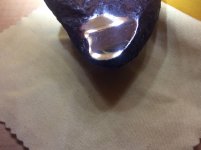twisttop
Jr. Member
- Jan 22, 2014
- 40
- 78
- Detector(s) used
- AT Pro, Fisher Goldbug, Whites coinmaster pro
- Primary Interest:
- All Treasure Hunting
I know it is rare to find a meteorite, but I believe I found one metal detecting. It is very heavy, magnetic and looks to have a fusion crust. I have ground a window and polished it. Ordered 5% Nitol to etch it. I see slight wadmanstatten lines, but they do not show up very well unless the light is just right. What am I doing wrong. The widmanstatten lines are very faint. Nothing like what I have seen on the Internet.











